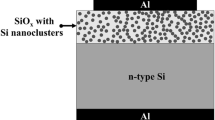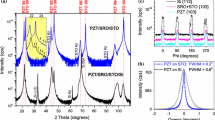Abstract
We demonstrate a novel optically tunable photosensitive capacitor (PSC) made from high-purity semi-insulating 4H-SiC. Photosensitive capacitors can provide continuously variable reactive tuning in RF circuitry or enable capacitive-optical sensing applications. Unlike varactors, PSCs often do not require a DC bias voltage to operate. To demonstrate the effect, we fabricated several 1cm x 1cm square photocapacitor devices from bulk material using metal-evaporated Ti/Au contacts using a simple planar parallel-gap geometry. IV curves were taken of the devices using an HP-4145B semiconductor parameter analyzer to verify Schottky behavior as a function of DC bias. The samples were then illuminated with pulsed below-bandgap 470 nm and 590 nm high intensity LED light sources. The resulting data demonstrated an increase in capacitance, Cs, and a drop in resistance, Rs, with increasing optical intensity incident on the device. The observed shifts in both Cs and Rs were repeatable. At a measurement frequency of 33 kHz. Cs increased from its nominal value of 186.7 pF to 575.6 pF while Rs dropped from 150.0 kΩ to 22.4 kΩ. This demonstrates the existence of the photocapacitance effect in high-purity semi-insulating 4H-SiC and thus warrants further investigation. The underlying phenomenon of the effect is suspected to be light interaction with the dominant deep level traps through the Shockley–Read–Hall (SRH) recombination mechanism.
Similar content being viewed by others
References
R. J. Kumar, J. M. Borrego, R. J. Gutmann, J. R. Jenny, D. P. Malta, H. M. Hobgood, and C. H. Carter, “Microwave photoconductivity decay characterization of high-purity 4H-SiC substrates,” J. Appl. Phys., vol. 102, no. 1, p. 013704, Jul. 2007.
A. Horsfall, “Review of “Advances in Silicon Carbide Processing and Applications” 1st Edition by Steven E. Saddow and Anant Agarwal,” BioMedicalEngineering OnLine, vol. 4. BioMed Central, p. 33, 2005.
P. B. Klein, B. V. Shanabrook, S. W. Huh, A. Y. Polyakov, M. Skowronski, J. J. Sumakeris, and M. J. O’Loughlin, “Lifetime-limiting defects in n[sup -] 4H-SiC epilayers,” Appl. Phys. Lett., vol. 88, no. 5, p. 052110, Feb. 2006.
N. Son, P. Carlsson, J. Ul Hassan, B. Magnusson, and E. Janzén, “Defects and carrier compensation in semi-insulating 4H-SiC substrates,” Phys. Rev. B, vol. 75, no. 15, pp. 1–8, 2007.
S. Singh and J. A. Cooper, “Bipolar Integrated Circuits in 4H-SiC,” IEEE Trans. Electron Devices, vol. 58, no. 4, pp. 1084–1090, Apr. 2011.
W. C. Mitchel, R. Perrin, J. Goldstein, M. Roth, S. R. Smith, J. S. Solomon, A. O. Evwaraye, H. M. Hobgood, G. Augustine, and V. Balakrishna, “The 1.1 eV deep level in 4H-SiC,” in Semiconducting and Insulating Materials, 1998. (SIMC-X) Proceedings of the 10th Conference on, 1998, pp. 283–286.
L. S. Lovlie, “Intrinsic bulk and interface defects in 4H silicon carbide.” 29-Jan-2013.
W. C. Mitchel, W. D. Mitchell, H. E. Smith, G. Landis, S. R. Smith, and E. R. Glaser, “Compensation mechanism in high purity semi-insulating 4H-SiC,” J. Appl. Phys., vol. 101, no. 5, p. -, 2007.
S. Dueñas, E. Castán, A. de Dios, L. Bailón, J. Barbolla, and A. Pérez, “Characterization of the EL2 center in GaAs by optical admittance spectroscopy,” J. Appl. Phys., vol. 67, no. 10, p. 6309, May 1990.
K. A. Boulais, F. Santiago, P. L. Wick, J. M. Mejeur, A. Rayms-Keller, M. S. Lowry, K. J. Long, and W. D. Sessions, “Circuit Analysis of Photosensitive Capacitance in Semi-Insulating GaAs,” IEEE Trans. Electron Devices, vol. 60, no. 2, pp. 793–798, Feb. 2013.
A. Goswami and A. P. Goswami, “Dielectric and optical properties of ZnS films,” Thin Solid Films, vol. 16, no. 2, pp. 175–185, May 1973.
G. B. Sakr and I. S. Yahia, “Effect of illumination and frequency on the capacitance spectroscopy and the relaxation process of p-ZnTe/n-CdMnTe/GaAs magnetic diode for photocapacitance applications,” J. Alloys Compd., vol. 503, no. 1, pp. 213–219, Jul. 2010.
M. Levinshtein, S. Rumyantsev, and M. Shur, Properties of advanced semiconductor materials: GaN, AlN, InN, BN, SiC, SiGe. Wiley, 2001.
M. B. J. Wijesundara and R. Azevedo, Silicon Carbide Microsystems for Harsh Environments, vol. 22. New York, NY: Springer New York, 2011.
L. S. Lovlie and B. G. Svensson, “Enhanced annealing of implantation-induced defects in 4H-SiC by thermal oxidation,” Appl. Phys. Lett., vol. 98, no. 5, p. 052108, Feb. 2011.
M. Kato, S. Tanaka, M. Ichimura, E. Arai, S. Nakamura, T. Kimoto, and R. Passler, “Optical cross sections of deep levels in 4H-SiC,” J. Appl. Phys., vol. 100, no. 5, p. 053708, Sep. 2006.
G. Liou, P. Lin, H. Yen, Y. Yu, and W. Chen, “Flexible Nanocrystalline-Titania / Polyimide Hybrids with High Refractive Index and Excellent Thermal Dimensional Stability,” Polymer (Guildf)., vol. 48, pp. 1433–1440, 2010.
M. E. Levinshtein, S. L. Rumyantsev, and M. Shur, Properties of advanced semiconductor materials: GaN, AlN, InN, BN, SiC, SiGe. Wiley, 2001, pp. 93–148.
W. C. Mitchel, R. Perrin, J. Goldstein, A. Saxler, M. Roth, S. R. Smith, J. S. Solomon, and A. O. Evwaraye, “Fermi level control and deep levels in semi-insulating 4H-SiC,” J. Appl. Phys., vol. 86, no. 9, p. 5040, Nov. 1999.
M. V. S. Chandrashekhar, I. Chowdhury, P. Kaminski, R. Kozlowski, P. B. Klein, and T. Sudarshan, “High Purity Semi-Insulating 4H-SiC Epitaxial Layers by Defect-Competition Epitaxy: Controlling Si Vacancies,” Appl. Phys. Express, vol. 5, no. 2, p. 025502, Feb. 2012.
S. Kumar, “Simulation of Trapping Effects in 4H-Silicon Carbide Metal Semiconductor Field Effect Transistor (4H-SiC MESFET).” 06-Jun-2011.
Author information
Authors and Affiliations
Rights and permissions
About this article
Cite this article
Register, J., Saddow, S.E. & Boulais, K. Photosensitive Capacitance Effect In High-purity Semi-insulating 4H-SiC. MRS Online Proceedings Library 1693, 148–158 (2014). https://doi.org/10.1557/opl.2014.603
Published:
Issue Date:
DOI: https://doi.org/10.1557/opl.2014.603




